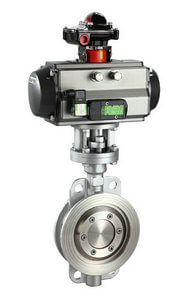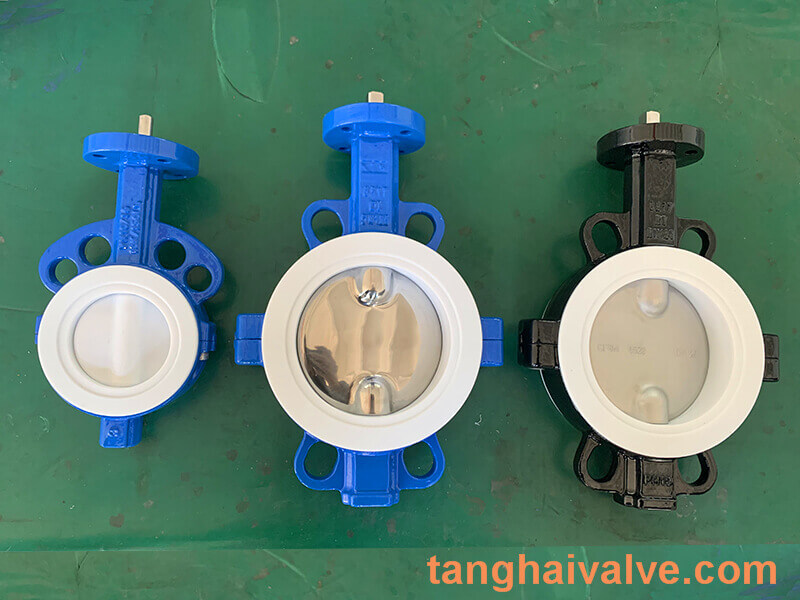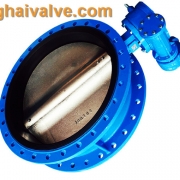pneumatic fluorine-lined butterfly valve vs pneumatic hard-sealed butterfly valve
The difference between pneumatic fluorine-lined butterfly valve and pneumatic hard-sealed butterfly valve
Pneumatic butterfly valve is an important execution unit with relatively large usage in industrial pipelines. Compressed air is used as the power source to operate the valve opening and closing, and the execution speed is very fast, usually only a few seconds! Pneumatic butterfly valve has simple structure, convenient operation and low cost. It can not only be used for quick shut-off, but also can be matched with valve positioner to receive relevant signals to achieve adjustment and control of pipeline medium pressure, flow, temperature and other parameters!

D673H-16C-stainless steel pneumatic triple eccentric butterfly valve
There are many types of pneumatic butterfly valves, which can fully meet the requirements of various working conditions, and can also customize the required butterfly valve products according to customer needs. Pneumatic fluorine-lined butterfly valve and pneumatic hard-sealed butterfly valve are two commonly used types. The medium and pressure temperature used are different. The control mode of the two is the same, but the sealing structure is completely different. Pneumatic fluorine-lined butterfly valve is suitable For pipelines that require sealing and contain corrosive media, but the pressure and temperature should not be too high, pneumatic hard-sealed butterfly valves can be used in various pressure and temperature ranges, with long service life, but poor sealing effect!
1. From the structure:
The hard sealing butterfly valve refers to that both sides of the sealing pair are made of metal materials or other harder materials. For soft sealing butterfly valves, the two contacting sealing surfaces can be separate or all of soft materials. For example, fluorine-lined butterfly valve means that the butterfly plate and valve seat are both wrapped in PTFE;
2. From the sealing performance:

Fluorine lined butterfly valve-PTFE-WAFER (8)
The advantage of soft-sealed fluorine-lined butterfly valve is good sealing performance, but the disadvantage is that it is easy to age, wear, and has a short service life. The hard seal butterfly valve has a long service life, but the sealing performance is relatively worse than that of the soft seal.
3. From the conditions of use:
The soft-sealed fluorine-lined butterfly valve is used in normal temperature and pressure environment, and the hard-sealed butterfly valve can be used in low temperature, normal temperature, high temperature and other environments. Generally, it can be used for higher pressure, but the soft seal is not. However, the fluorine-lined butterfly valve has super corrosion resistance!
4. From the manufacturing point of view:
As for manufacturing, from a principle point of view, there is little difference between the two, mainly the difference in valve seats. The soft-seal fluorine-lined butterfly valve is a non-metallic structure, and the hard-seal butterfly valve is a metal structure. The hardness relationship between metals and the workmanship must be considered. Situation, what medium to go and so on. The choice between pneumatic fluorine-lined butterfly valve and pneumatic hard-sealed butterfly valve is mainly based on the process medium, temperature and pressure. Generally, the medium contains solid particles and is worn, or the temperature is higher than 200 degrees. It is best to choose hard-sealed butterfly valves!
Related knowledge: Pneumatic butterfly valve working principle diagram; Pneumatic butterfly valve model compilation method
TH Valve is a professional manufacturer of butterfly valve, gate valve, check valve, globe valve, knife gate valve, ball valve with API, JIS, DIN standard, used in Oil, Gas, Marine industry, Water supply and drainage, fire fighting, shipbuilding, water treatment and other systems, with Nominal Diameter of DN50 to DN1200, NBR/EPDM/VITON, Certificates & Approvals: DNV-GL, Lloyds, DNV, BV, API, ABS, CCS. Standards: EN 593, API609, API6D

 tanghaivalve.com
tanghaivalve.com

 © Copyright 2020 Tianjin Tanghaidongyang Valve Co., Ltd. All Rights Reserved.
© Copyright 2020 Tianjin Tanghaidongyang Valve Co., Ltd. All Rights Reserved.